Qualcomm® Snapdragon™ Mobile Platform OpenCL General Programming and Optimization
Revision history
Contents
Figures
Tables
1 Introduction
1.1 Purpose
1.2 Conventions
1.3 Technical assistance
2 Introduction to OpenCL
2.1 OpenCL background and overview
2.2 OpenCL on mobile
2.3 OpenCL standard
2.3.1 OpenCL API functions
2.3.2 OpenCL C language
2.3.3 OpenCL versions and profiles
2.4 OpenCL portability and backward compatibility
2.4.1 Program portability
2.4.2 Performance portability
2.4.3 Backward compatibility
3 OpenCL on Snapdragon
3.1 OpenCL on Snapdragon
3.2 Adreno GPU architecture
3.2.1 Adreno high-level architecture for OpenCL
3.2.2 Waves and fibers
3.2.3 Latency hiding
3.2.4 Workgroup assignment
3.3 Adreno A3x, A4x, and A5x differences on OpenCL
3.3.1 L2 cache
3.3.2 Local memory
3.4 Context switching between graphics and compute workload
3.4.1 Context switch
3.4.2 Limit kernel/workgroup execution time on GPU
3.5 OpenCL standard related improvement
3.6 OpenCL extensions
4 Adreno OpenCL application development
4.1 OpenCL application development on Android
4.2 Debugging tools
4.3 Snapdragon Profiler
4.4 Performance profiling
4.4.1 CPU timer
4.4.2 GPU timer
4.4.3 GPU timer vs. CPU timer
4.4.4 Performance mode
4.4.5 GPU frequency controls
5 Overview of performance optimizations
5.1 Performance portability
5.2 High-level view of optimization
5.3 Initial evaluation for OpenCL porting
5.4 Port CPU code to OpenCL GPU
5.5 Parallelize GPU and CPU workloads
5.6 Bottleneck analysis
5.6.1 Identify bottlenecks
5.6.2 Resolve bottlenecks
5.7 API level performance optimization
5.7.1 Proper arrangement of API function calls
5.7.2 Use event-driven pipeline
5.7.3 Kernel loading and building
5.7.4 Use in-order command queues
6 Workgroup size performance optimization
6.1 Obtain the maximum workgroup size
6.2 Required and preferred workgroup size
6.3 Factors affecting the maximum workgroup size
6.4 Kernels without barrier
6.5 Workgroup size tuning
6.5.1 Avoid using default workgroup size
6.5.2 Large workgroup size, better performance?
6.5.3 Fixed vs. dynamic workgroup size
6.5.4 One vs. two vs. three-dimensional (1D/2D/3D) workgroup
6.6 Other topics on workgroup size
6.6.1 Global work size and padding
6.6.2 Brute force search
6.6.3 Avoid uneven workload across workgroups
6.6.4 Workgroup synchronization
7 Memory performance optimization
7.1 OpenCL memories in Adreno GPUs
7.1.1 Local memory
7.1.2 Constant memory
7.1.3 Private memory
7.1.4 Global memory
7.1.4.1 Buffer
7.1.4.2 Image
7.1.4.3 Using image object vs. buffer object
7.1.4.4 Use of both Image and buffer objects
7.1.4.5 Global memory vs. local memory
7.2 Optimal memory load/store
7.2.1 Coalesced memory load/store
7.2.2 Vectorized load/store
7.2.3 Optimal data type
7.2.4 16-bit floating (half) vs. 32-bit floating
7.3 Atomic functions
7.4 Zero copy
7.4.1 Use map over copy
7.4.2 Avoid memory copy for objects allocated not by OpenCL
7.4.2.1 ION memory extensions
7.4.2.2 QTI Android native buffer (ANB) extension
7.4.2.3 Using standard EGL extensions
7.5 Improve cache usage
7.6 CPU cache operations
7.7 Use of SVM
7.8 Best practices to reduce power/energy consumption
8 Kernel performance optimization
8.1 Kernel fusion or splitting
8.2 Compiler options
8.3 Conformant vs. fast vs. vs. native math functions
8.4 Loop unrolling
8.5 Avoid branch divergence
8.6 Handle image boundaries
8.7 32-bit vs. 64-bit GPU memory access
8.8 Avoid use of size_t
8.9 Generic memory address space
8.10 Miscellaneous
9 OpenCL optimization case studies
9.1 Application sample code
9.1.1 Improve algorithm
9.1.2 Vectorized load/store
9.1.3 Use image instead of buffer
9.2 Epsilon filter
9.2.1 Initial implementation
9.2.2 Data pack optimization
9.2.3 Vectorized load/store optimization
9.2.4 Further increase work load per work item
9.2.5 Use local memory optimization
9.2.6 Branch operations optimization
9.2.7 Summary
9.3 Sobel filter
9.3.1 Algorithm optimization
9.3.2 Data pack optimization
9.3.3 Vectorized load/store optimization
9.3.4 Performance and summary
9.4 Summary
10 Summary
A How to enable performance mode
A.1 Adreno A3x GPU
A.1.1 CPU settings
A.1.2 GPU settings:
A.2 Adreno A4x GPU and Adreno A5x GPU
B References
B.1 Related documents
B.2 Acronyms and terms
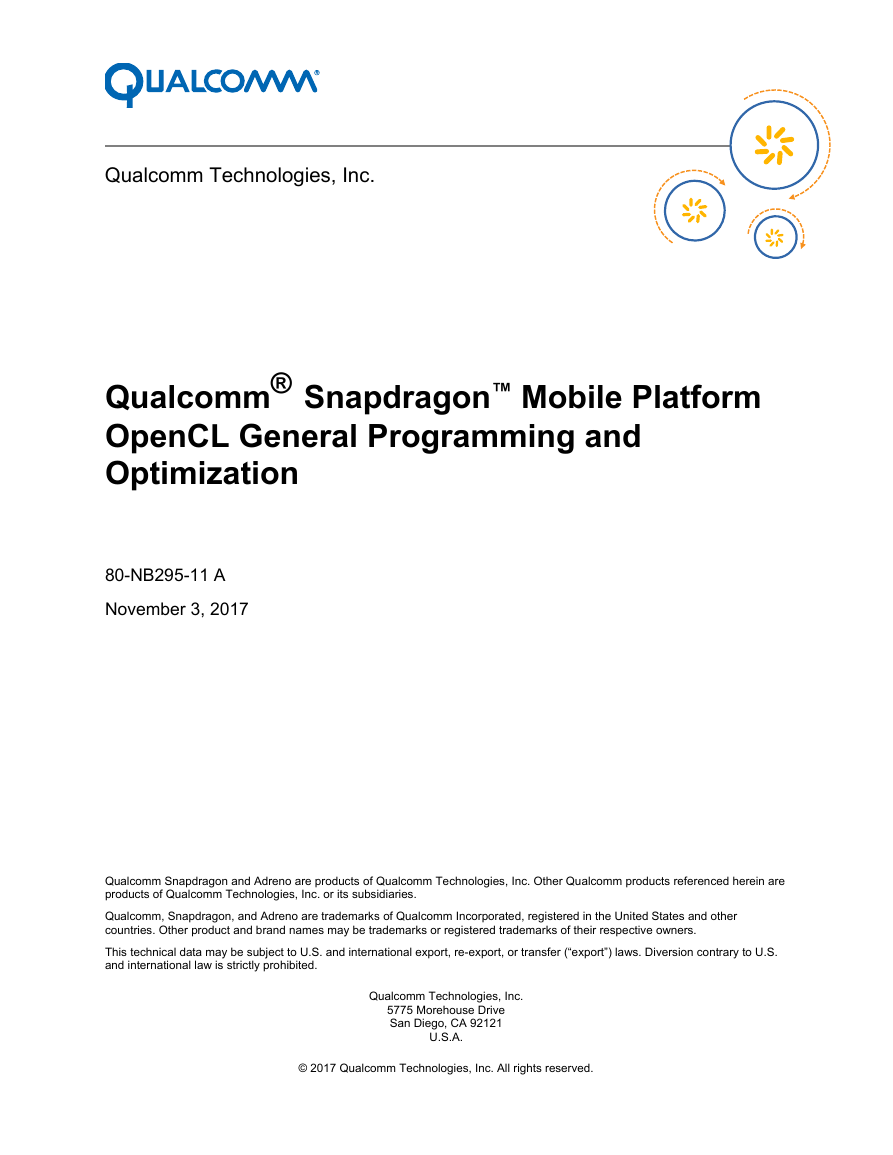

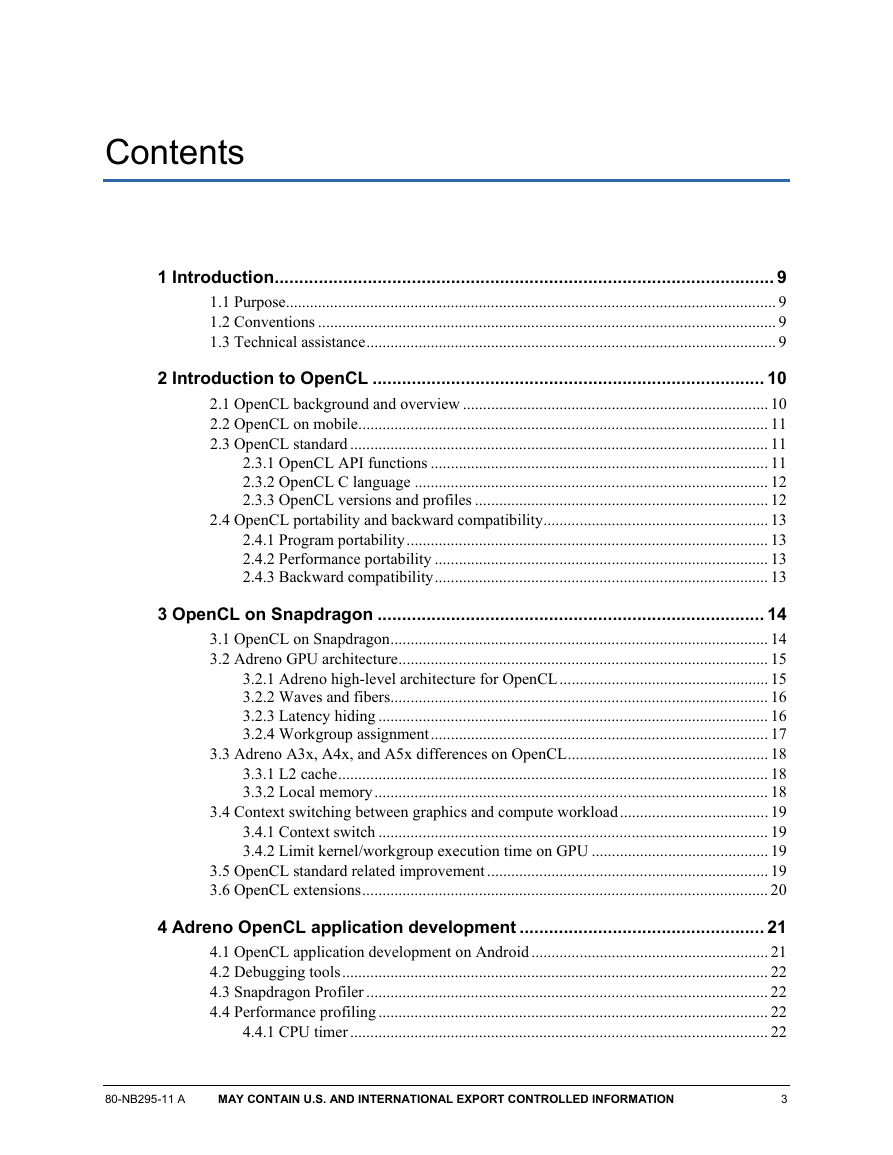
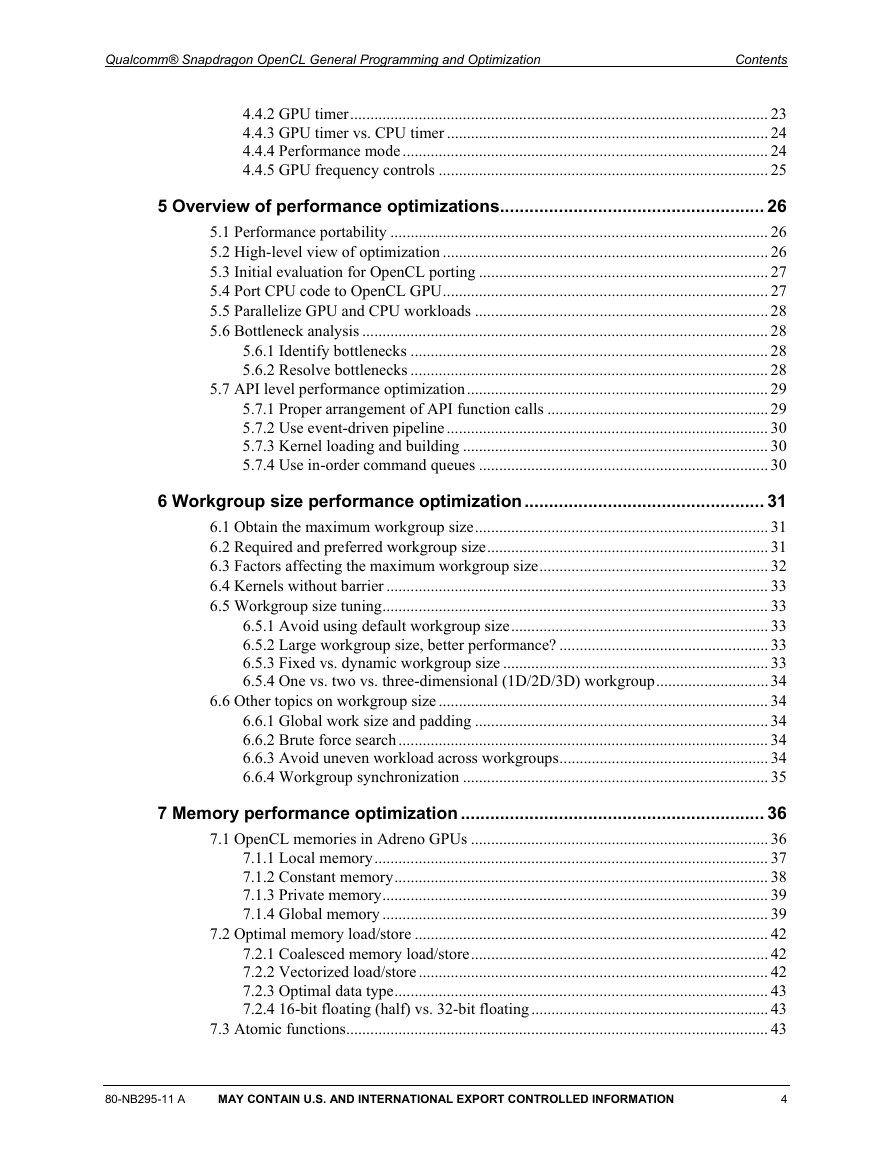
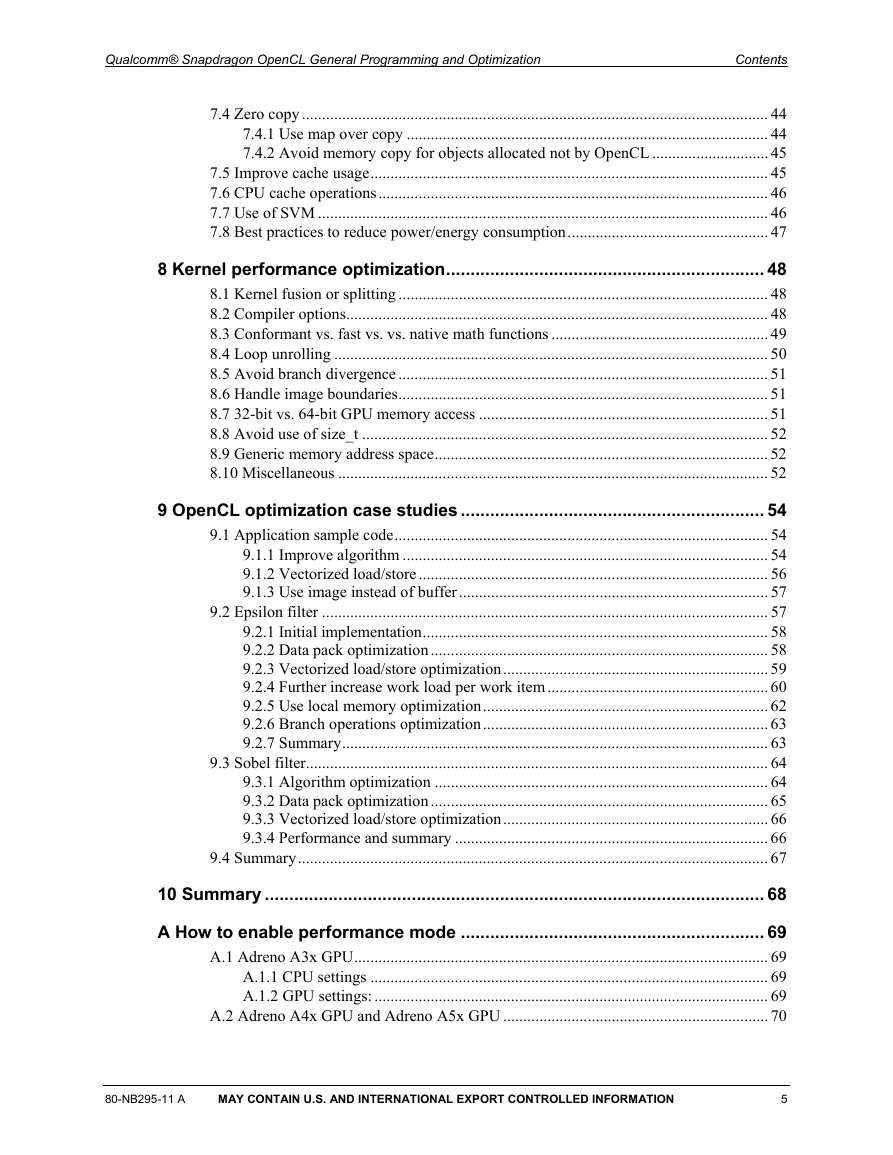

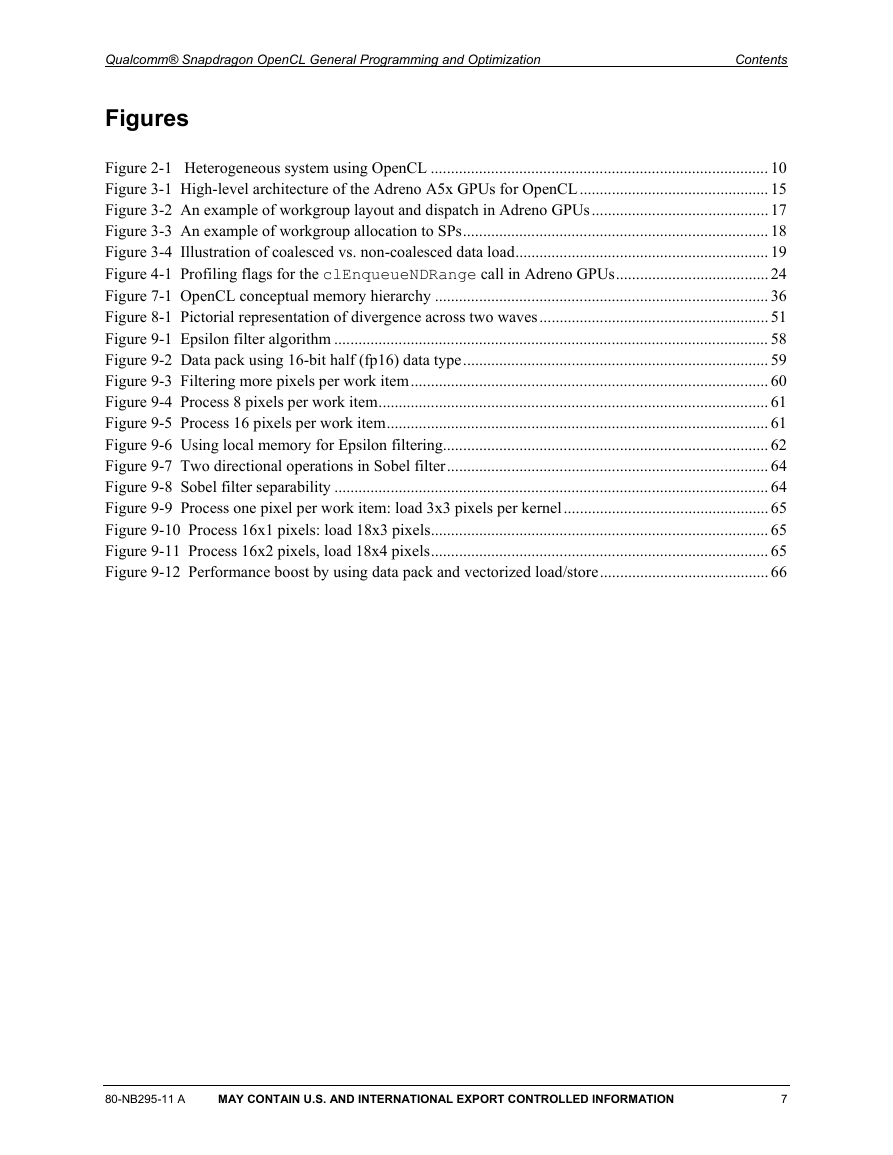
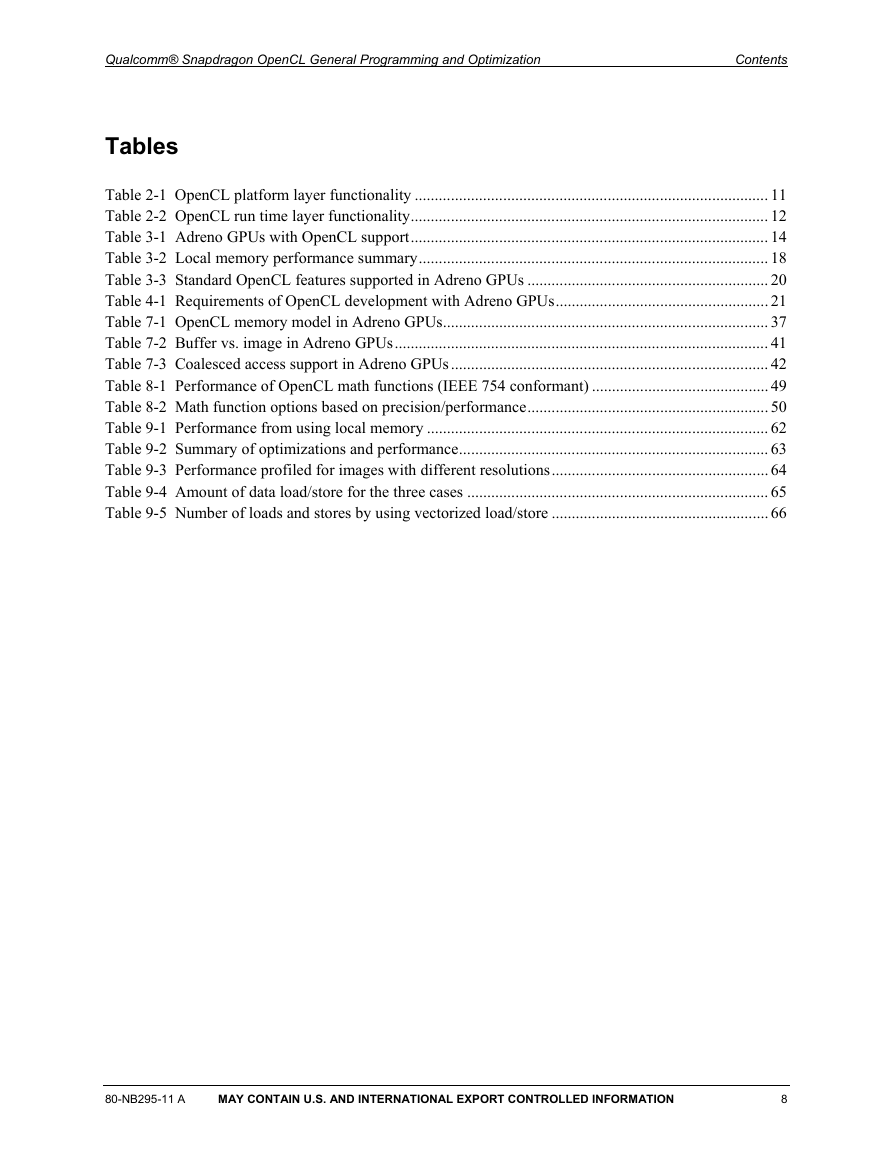








 2023年江西萍乡中考道德与法治真题及答案.doc
2023年江西萍乡中考道德与法治真题及答案.doc 2012年重庆南川中考生物真题及答案.doc
2012年重庆南川中考生物真题及答案.doc 2013年江西师范大学地理学综合及文艺理论基础考研真题.doc
2013年江西师范大学地理学综合及文艺理论基础考研真题.doc 2020年四川甘孜小升初语文真题及答案I卷.doc
2020年四川甘孜小升初语文真题及答案I卷.doc 2020年注册岩土工程师专业基础考试真题及答案.doc
2020年注册岩土工程师专业基础考试真题及答案.doc 2023-2024学年福建省厦门市九年级上学期数学月考试题及答案.doc
2023-2024学年福建省厦门市九年级上学期数学月考试题及答案.doc 2021-2022学年辽宁省沈阳市大东区九年级上学期语文期末试题及答案.doc
2021-2022学年辽宁省沈阳市大东区九年级上学期语文期末试题及答案.doc 2022-2023学年北京东城区初三第一学期物理期末试卷及答案.doc
2022-2023学年北京东城区初三第一学期物理期末试卷及答案.doc 2018上半年江西教师资格初中地理学科知识与教学能力真题及答案.doc
2018上半年江西教师资格初中地理学科知识与教学能力真题及答案.doc 2012年河北国家公务员申论考试真题及答案-省级.doc
2012年河北国家公务员申论考试真题及答案-省级.doc 2020-2021学年江苏省扬州市江都区邵樊片九年级上学期数学第一次质量检测试题及答案.doc
2020-2021学年江苏省扬州市江都区邵樊片九年级上学期数学第一次质量检测试题及答案.doc 2022下半年黑龙江教师资格证中学综合素质真题及答案.doc
2022下半年黑龙江教师资格证中学综合素质真题及答案.doc